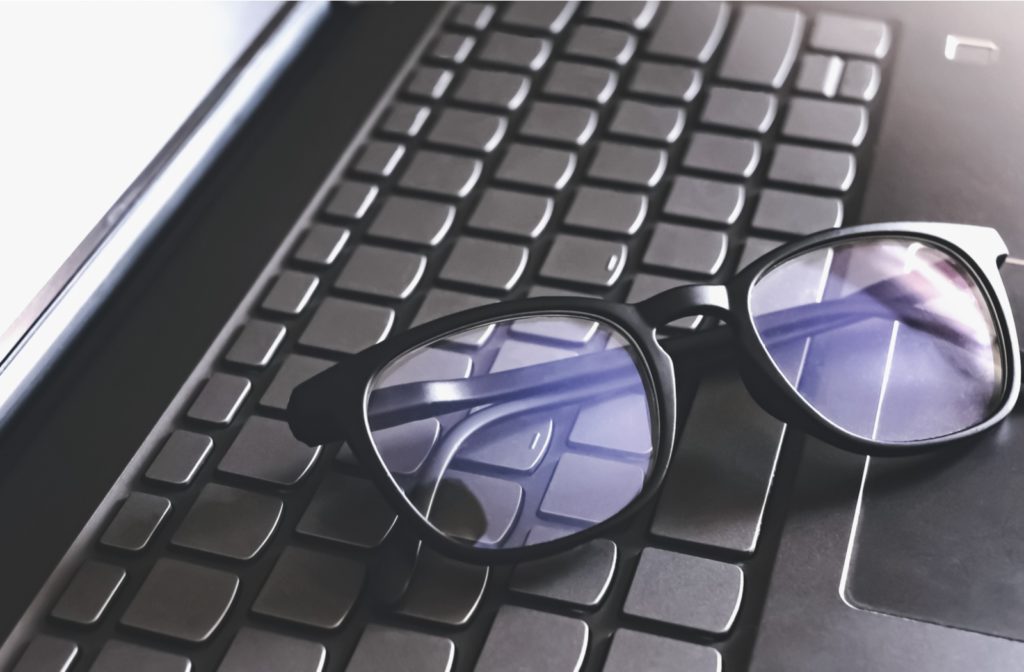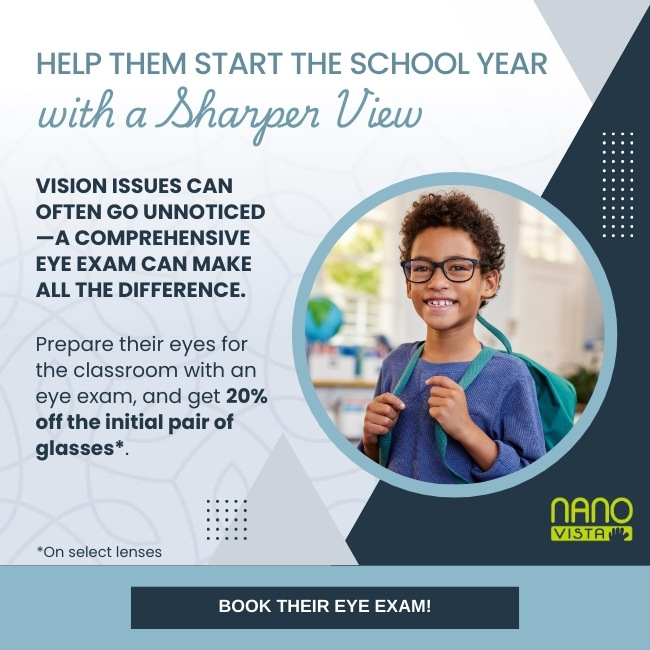Blue light glasses are a hot topic. With many of us using our phones and computers for work and play, a pair of glasses to protect our eyes from the light of a glowing screen seems like a no-brainer.
But what is blue light? Why are people using glasses to block it? And can blue light glasses be worn all the time? Let’s dive deeper into understanding blue light, the effects it can have on our eyes and body, and its relationship to digital eye strain.
What is Blue Light?
All light that we’re able to see falls within a spectrum of colour. The length of visible light waves ranges from 380 nanometers (violet light) to 700 nanometers (red light). Blue light waves are on the faster end of the spectrum, not far from ultraviolet (UV) waves, which are known to be damaging to human tissues.
Blue light is all around us. It’s produced by fluorescent lights, incandescent lights, LED lights, and the digital devices we use. The most abundant source of blue light? The sun.
Blue light offers some benefits but also has the potential to harm us. The pros of blue light include:
- Keeping us alert
- Improving cognitive function
- Regulating our circadian rhythm with the natural day-night cycle
- Some skin benefits, like reducing acne
- Potentially helping reduce symptoms of seasonal affective disorder
On the flip side, too much of nearly anything can cause trouble. Some cons of blue light are:
- The potential to disrupt our circadian rhythm when we are exposed to too much blue light
- Increased risk of macular degeneration
- Increases digital eye strain
Blue Light & Digital Eye Strain
One of the main causes for concerns about blue light is the increased amount of blue light we take in thanks to our increased reliance on technology such as digital devices. This has proved to be especially true during the Covid-19 pandemic—a 2020 study reports that 48% of those surveyed were using a digital device from 9-14 hours a day, and about 93% said their screen usage rose during the pandemic.
Our eyes can manage the natural blue light in the world around us, but there’s a chance that increased blue light exposure may lead to digital eye strain.
Eye strain occurs when our eyes are required to focus intently on a task for long periods. Digital eye strain refers specifically to computer and screen-focused tasks. Symptoms of digital eye strain include:
- Headaches
- Blurred vision
- Watery eyes
- Dry eyes
- Sore shoulders, neck, or back
- Light sensitivity
- Eye fatigue
Digital eye strain is normally not a serious condition, but it can interfere with your vision and quality of life. It’s difficult to avoid all screens (especially if your phone or computer is a major part of your work or hobbies), but there are ways to reduce digital eye strain.
Alongside taking regular breaks, remembering to blink frequently, and maintaining proper posture, a popular solution is using blue-light-blocking lenses—often called blue light glasses.

Eye Protection from the Experts
We have some natural protection from UV rays (though it’s still critical to wear well-made sunglasses that block 100% of UVA and UVB rays!), but our eyes aren’t very good at blocking blue light. It seems like an obvious solution to use blue light glasses while using a digital device or screen.
Don’t rush off to a big box store or online mega-retailer just yet! As with all things eye-related, it’s safest and smartest to visit your optometrist for high-quality care and products. Your optometrist will be able to determine the right type of blue-light-blocking lens for you.
It’s also likely blue light exposure isn’t the only cause of your eye strain. With a comprehensive eye exam, your optometrist can make sure there aren’t any underlying eye health problems and that your prescription lenses are up to date. Incorrect or outdated lenses lead to squinting, headaches, and eye strain. Throwing cheap blue light glasses on with a pair of old contact lenses that don’t correct your vision properly won’t help your problem.
Your optometrist has the expertise to help manage and diagnose the impact of digital eye strain. Instead of using a bandaid solution from the corner store, get to the bottom of your eye issues.
Types of Lens Coatings
If you already use prescription glasses, your optometrist can give them an upgrade with lens coatings designed to enhance your lenses and offer further protection and clearer vision.
Blue Light
Blue light coatings help block out part of the blue light we’re exposed to daily. This may help protect our delicate retina, which is susceptible to light damage.
Anti-Reflective
Reflections and glare are annoying, and they can interfere with the clarity of our vision. Anti-reflective coatings stop reflections from getting in the way of our sight. They also have the benefit of reducing the glare that bounces off your lenses, allowing people who look at you to see your eyes without obstruction.
Scratch-Resistant
No lenses are scratch-proof, but a scratch-resistant coating makes your glasses more durable. Fewer scratches mean less interference with your vision. This type of coating may appeal to those of us who are prone to dropping our glasses or lead very active lifestyles—and, of course, children’s glasses could always benefit from a bit of extra protection.
Anti-Fog
Those of us who wear glasses in northern Alberta is no stranger to the dreaded glasses fog. In inclement weather, especially the cold, moving from outdoors to a warm indoor environment causes lenses to fog, obstructing sight. Anti-fog coatings work to reduce the amount of condensation that can collect on your glasses, keeping your lenses the way they were intended to be—transparent—more often.
Keep Your Vision Clear & Protected with Doctors EyeCare
If digital eye strain is irritating you, or you’re interested in blue-light-blocking glasses or lens coatings, book an appointment with us. Dr. Shonah Finlay and her team are here to offer you guidance and top-notch eye care in our welcoming clinic.




